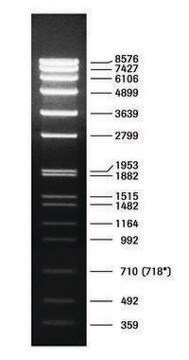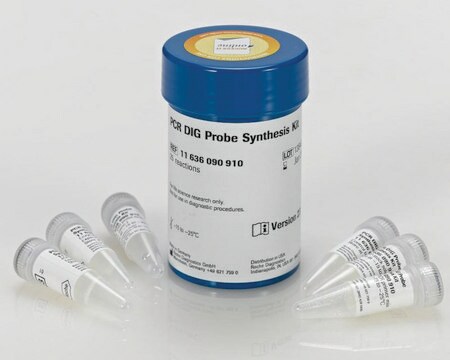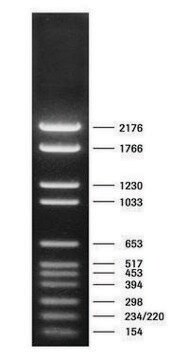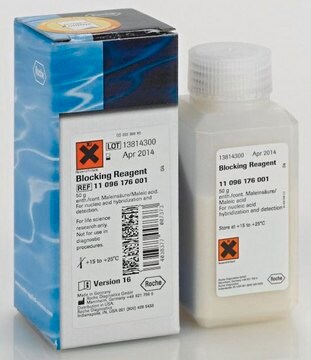11218590910
Roche
DNA Molecular Weight Marker II, DIG-labeled
solution, pkg of 500 μL (10 μg/ml)
Sinônimo(s):
DNA marker
About This Item
Produtos recomendados
Formulário
solution
Nível de qualidade
embalagem
pkg of 500 μL (10 μg/ml)
fabricante/nome comercial
Roche
características do produto alternativo mais ecológico
Designing Safer Chemicals
Learn more about the Principles of Green Chemistry.
sustainability
Greener Alternative Product
concentração
10 μg/mL
cor
colorless
solubilidade
water: miscible
categoria alternativa mais ecológica
, Aligned
temperatura de armazenamento
−20°C
Descrição geral
Aplicação
Características e benefícios
Ready-to-use solutions in 10mM Tris-HCl, 1mM EDTA, pH 8.0.
Sequência
Note: Fragment lengths are derived from computer analysis of the DNA sequence. Depending on the size range of the marker, the smallest fragments will only be visible on overloaded gels.
Outras notas
Código de classe de armazenamento
12 - Non Combustible Liquids
Classe de risco de água (WGK)
nwg
Ponto de fulgor (°F)
No data available
Ponto de fulgor (°C)
No data available
Escolha uma das versões mais recentes:
Já possui este produto?
Encontre a documentação dos produtos que você adquiriu recentemente na biblioteca de documentos.
Os clientes também visualizaram
Artigos
Digoxigenin (DIG) labeling methods and kits for DNA and RNA DIG probes, random primed DNA labeling, nick translation labeling, 5’ and 3’ oligonucleotide end-labeling.
Nossa equipe de cientistas tem experiência em todas as áreas de pesquisa, incluindo Life Sciences, ciência de materiais, síntese química, cromatografia, química analítica e muitas outras.
Entre em contato com a assistência técnica




